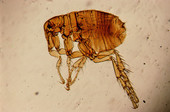- Understanding the Connection Between Anxiety and Depression
- How Daily Prunes Can Influence Cholesterol and Inflammation
- When to Take B12 for Better Absorption and Energy
- Epsom Salts: Health Benefits and Uses
- See What Saffron Can Do for Sleep and Heart Health
- 6 Common Mistakes to Avoid Before Your Physical
- Can Sweating Really Help You Beat a Cold?
- Strengthening Your Relationship: Practical Strategies
- Skip Storing This Everyday Product in the Fridge Door
- Green Tea + B3 Pairing May Boost Brain Health
Did One Gene Mutation Launch the Black Death?


One small genetic change may have transformed Yersinia pestis — the plague bacteria — from a relatively mild germ into the deadly bug that killed millions in the Black Death and other historic epidemics, scientists report.
According to the U.S. Centers for Disease Control and Prevention, humans can contract Y. pestis after being bitten by a flea carried by a rodent or by handling the rodent themselves. While antibiotics can effectively treat plague today, an epidemic in the mid-1300s wiped out up to 60 percent of Europe’s population, the CDC said.
But what made the germ — which can trigger bubonic, pneumonic or septicemic plague — so lethal?
To find out, a team led by Wyndham Lathem, an assistant professor in microbiology-immunology at Northwestern University’s Feinberg School of Medicine in Chicago, examined ancestral strains of Y. pestis in mice.
They wanted to learn when and how the bacterium evolved from a bug that primarily caused an illness in the digestive tract, to one that could infect the lungs and cause the most severe form of plague, pneumonic plague.
The oldest ancestor of currently existing strains of the bacteria can infect the lungs, but it doesn’t result in the deadly respiratory disease that killed so many, Lathem’s group said.
The main difference between this strain and others that could cause pneumonic plague is a gene known as Pla, the study revealed.
The researchers theorized that the acquisition of this gene not only helped the bacteria infect the lungs, but also enabled it to cause a more serious, often fatal infection.
To test the theory, the team inserted the Pla gene into the less-lethal ancestral strain of the bacteria. They then watched how it affected the lungs.
As expected, the mutated strain became more deadly and was able to cause respiratory infections as serious as modern-day strains of Y. pestis.
The bacterium has gained and lost numerous genes over thousands of years, but the Pla gene was all it took for the bacteria to become so deadly, the Chicago team said.
After examining variations of the Pla gene, the study’s authors also found a gene tweak only found in more modern strains of the bacteria — this change enabled it to spread to the lymph nodes, causing bubonic plague.
“Our data suggests that the insertion and then subsequent mutation of Pla allowed for new, rapidly evolving strains of disease,” Lathem said. “This information can show how new respiratory pathogens could emerge with only small genetic changes.”
“Our findings demonstrate how Y. pestis had the ability to cause a severe respiratory disease very early in its evolution,” Lathem said in a Northwestern news release. “This research helps us better understand how bacteria can adapt to new host environments to cause disease by acquiring small bits of DNA.”
They concluded their findings could also help explain how Y. pestis infections advanced from small, local outbreaks of plague to pandemics like the sixth century’s Justinian Plague and the fourteenth century’s Black Death.
The study is published June 30 in the journal Nature Communications.
More information
The U.S. Centers for Disease Control and Prevention provides more information on the Yersinia pestis, the bacterium that causes plague.
Source: HealthDay
Copyright © 2026 HealthDay. All rights reserved.










